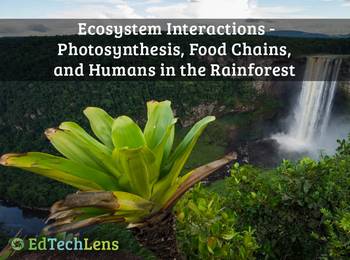Food Chains, Energy, & Habitat Destruction in Rainforest Ecosystems – Unit PDF
- PDF
- Easel Activity
Description
TITLE
Food Chains, Energy, & Habitat Destruction in Rainforest Ecosystems – Unit PDF
OVERVIEW
Students learn through reading passages, engaging media (photos, graphic organizers, video and audio clips), and a hands-on activity about how energy and balance in ecosystems; food chains; decomposition; and human impacts on the rainforest. Assessments, answer keys, Easel Activities, and teacher support are included. The high-interest rainforest theme is used to teach this NGSS-aligned life science unit. Content is engaging and helps meet nonfiction literacy requirements
GRADE LEVELS AND PERFORMANCE EXPECTATIONS
This 77 page unit was created for students in grade 5, and it may also be appropriate for students in grades 4. It typically takes about 9 sessions to teach. The number of sessions depends on depth of study and the amount of time devoted to class discussion. The content and media have been designed to encourage class discussion. The timing recommendation is based on an estimate of 40 minutes per lesson for grades 3-5.
The following performance expectations are addressed:
5-PS3-1 Use models to describe that energy in animals’ food (used for body repair, growth, motion, and to maintain body warmth) was once energy from the sun.
5-ESS3-1 Obtain and combine information about ways individual communities use science ideas to protect the Earth’s resources and environment.
5-LS2-1 Develop a model to describe the movement of matter among plants, animals, decomposers, and the environment. Emphasis is on the idea that matter that is not food (air, water, decomposed materials in soil) is changed by plants into matter that is food.
4-ESS3-2. Generate and compare multiple solutions to reduce the impacts of natural Earth processes on humans.
Screen reader support enabled.
CONCEPT DETAILS .
-- energy in ecosystems
-- food chains
-- fungi and decomposition
-- balance in ecosystems
-- how people use the rainforest
-- rainforest destruction and its effects
-- results of overfishing
-- includes chart and graphing activity
UNIT COMPONENTS
-- High-quality reading passages
-- Text is supplemented with rich media
-- Brief intro video and graphic organizers summarize main concepts
-- Assessments include summative and formative assessments with answer key
-- Teacher document details NGSS alignments
-- Two versions (classroom and home user) of 5E hands-on activity included
-- All pages easily printable as PDFs
NOT YOUR PREFERRED FILE TYPE?
This is a PDF file. An EPUB (eBook) version with audio support is also available on this site.
HOW TO USE
The format allows for teacher-led lessons on a digital display as well as small group or individual use on computers. Students can use independently on iPads or computers for enrichment, reinforcement, or at science centers.
NOTE TITLE DIFFERENCES WITHIN THIS PRODUCT
The title shown on the cover in the preview and upon purchase may not be the same. The cover title is the student-friendly name. The title shown on TpT has been rewritten to give educators concept information.
OTHER TYPES OF EDTECHLENS CONTENT
Single or bundled 5E and PBL hands-on activities
Primary sources such as scientist interviews and trip journals
Media resource packs of graphic organizers and video clip collections
Some content may have been used in other EdTechLens products.
©EdTechLens
Usage of any material, including text and media, in this lesson pack is illegal except for use by the single teacher or home user who has purchased it. Please do not share with another user or online. Doing so is a violation of copyright and the Digital Millennium Copyright Act (DMCA).






